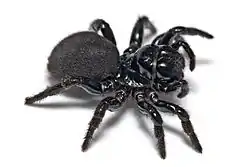Missulena
Missulena is a genus of mygalomorph spiders in the family Actinopodidae, sometimes called mouse spiders. It was first described by Charles Athanase Walckenaer in 1805.[2] M. tussulena is found in Chile, but the rest are indigenous to Australia.[3]
| Missulena | |
|---|---|
 | |
| Male Missulena occatoria | |
| Scientific classification | |
| Kingdom: | Animalia |
| Phylum: | Arthropoda |
| Subphylum: | Chelicerata |
| Class: | Arachnida |
| Order: | Araneae |
| Infraorder: | Mygalomorphae |
| Family: | Actinopodidae |
| Genus: | Missulena Walckenaer, 1805[1] |
| Type species | |
| M. occatoria Walckenaer, 1805[1] | |
| Species | |
|
18, see text | |
The term "mouse spider" comes from the now-disproven belief that they dig deep burrows similar to those of mice. Scotophaeus blackwalli also shares the common name "mouse spider", but is actually quite different. It is in a different family, is not a mygalomorph, is much smaller, looks very different, and is not considered dangerous.
Description
Mouse spiders are medium-to-large spiders which range in length from 1 cm to 3 cm. Their carapace is glossy, and they have high, broad heads, with eyes spread out across the front of the head.[4][5] They have short spinnerets, located in the rear of the abdomen. Mouse spiders exhibit sexual dimorphism, with female spiders being all-black; and male spiders having species-specific colouration. The male eastern mouse spider (M. bradleyi) has a bluish patch, and the male red-headed mouse spider (M. occatoria) is brownish or blue-black in color, with bright red-tinged jaws.[6]
Mouse spiders prey mainly on insects, though they may consume other small animals as opportunity presents. The primary predators of the mouse spider include wasps, centipedes, and scorpions.
Habitat and range
The mouse spiders have a Gondwanan distribution, with one species found in Chile and the rest distributed throughout Australia, while the nearest related genera occur elsewhere in South America . Similar to trapdoor spiders, mouse spiders live in burrows covered with trapdoors, which can extend to nearly 30 cm (1 ft) in depth. Female mouse spiders generally remain in their burrows; the males wander in search of mates.
Medical significance
Mouse spiderbites are painful but not generally dangerous, as serious envenomations are relatively rare; most mouse spider bites documented in the medical literature did not require use of antivenom or involve serious symptoms. However, they are often visually confused with funnel web spiders and so any bite should be initially treated as potentially that of a funnel web. [7]The venom of the eastern mouse spider (M. bradleyi) was found to have toxins similar to the robustoxin found in Australian funnel-web spider venom; and Australian funnel-web spider antivenom has been found to be effective in treating severe mouse spider bites. Unlike the Australian funnel-web spiders, however, the mouse spider is far less aggressive towards humans, and may often give "dry" bites.
Some evidence suggests that the bite of a mouse spider is potentially as serious as that of an Australian funnel-web spider; however, recorded bites by this spider are rare, despite the abundance of some species amid human habitation. Funnel-web antivenom has been found to be an effective treatment for serious bites.[4][5]
Species

As of March 2019, it contains 18 species.[1]
- Missulena bradleyi Rainbow, 1914—Australia (New South Wales)
- Missulena dipsaca Faulder, 1995—Australia
- Missulena faulderi Harms & Framenau, 2013—Australia (Western Australia)
- Missulena granulosa (O. Pickard-Cambridge, 1869)—Australia (Western Australia)
- Missulena harewoodi Framenau & Harms, 2017—Australia (Western Australia)
- Missulena hoggi Womersley, 1943—Australia (Western Australia)
- Missulena insignis (O. Pickard-Cambridge, 1877)—Australia
- Missulena langlandsi Harms & Framenau, 2013—Australia (Western Australia)
- Missulena leniae Miglio, Harms, Framenau & Harvey, 2014—Australia (Western Australia)
- Missulena mainae Miglio, Harms, Framenau & Harvey, 2014—Australia (Western Australia)
- Missulena melissae Miglio, Harms, Framenau & Harvey, 2014—Australia (Western Australia)
- Missulena occatoria Walckenaer, 1805—Southern Australia
- Missulena pinguipes Miglio, Harms, Framenau & Harvey, 2014—Australia (Western Australia)
- Missulena pruinosa Levitt-Gregg, 1966—Australia (Western Australia, Northern Territory)
- Missulena reflexa Rainbow & Pulleine, 1918—Australia (South Australia)
- Missulena rutraspina Faulder, 1995—Australia (Western Australia, South Australia, Victoria)
- Missulena torbayensis Main, 1996—Australia (Western Australia)
- Missulena tussulena Goloboff, 1994—Chile
References
- "Gen. Missulena Walckenaer, 1805". World Spider Catalog. Natural History Museum Bern. Retrieved 2019-03-27.
- Walckenaer, C. A. (1805). Tableau des aranéides ou caractères essentiels des tribus, genres, familles et races que renferme le genre Aranea de Linné, avec la désignation des espèces comprises dans chacune de ces divisions.
- Goloboff, P.A. (1994), Migoidea de Chile, nuevas o poco conocidas (Araneae: Mygalomorphae). Revista de la Sociedad Entomológica Argentina (in Spanish), 53, pp. 65–74
- "Mouse Spiders". Sciencentre. Retrieved 2016-06-28.
- "Mouse Spiders". Australian Museum. Retrieved 2016-06-28.
- Womersley, H. (1943), "A revision of the spiders of the genus Missulena Walckenaer 1805", Records of the South Australian Museum, 7: 251–265
- https://www1.health.nsw.gov.au/pds/ActivePDSDocuments/GL2014_005.pdf